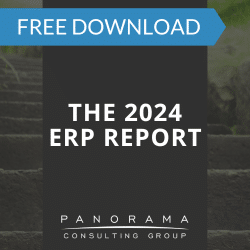The world of enterprise resource planning (ERP) is rapidly evolving. If you’re considering digital transformation, then monitoring ERP trends and the future of these systems is a must.
Wondering which ERP trends to prioritize next year? Tools and technology designed to support agility and intelligent decision-making should be on the top of your list.
Today, we’re looking at the trends in ERP systems that are changing the game and discussing how business leaders can maximize their ERP investments as we move into the future of automation.
1. More Cloud-Based ERP Deployments
Vendors continue to invest in cloud technology in lieu of on-premise systems.
Cloud models offer many benefits, including the ability for smaller companies to ramp up their IT investments, even if their internal tech departments are relatively small. With user-friendly apps and cross-platform capabilities, cloud ERP is making it more feasible for these companies to adopt more advanced technologies down the road.
Note: The most mature cloud ERP functionality is found in the top ERP systems as featured in our industry report.
The 2025 Top 10 ERP Systems Report
What vendors are you considering for your ERP implementation? This list is a helpful starting point.
2. IoT-Connected Devices
Mobile ERP has been around for decades, but businesses are expanding the way they look at this technology. Leveraging the ever-growing Internet of Things (IoT), leaders are enabling more connected, multi-device experiences.
For example, companies are using IoT-connected sensors to monitor equipment, products, and a slew of other physical assets. In turn, they’re gleaning insights in areas such as:
- Employee performance
- System efficiency
- Energy use
- User downtime
- Assembly speeds
- Shipping timeframes
3. A Move Toward Two-Tier ERP
When companies are spread across multiple offices, subsidiaries, and geographic locations, it can be difficult to house all company data in one ERP platform. Many locations have their own specialized requirements, and trying to fit their needs into a one-size-fits-all solution can be a recipe for disaster.
This is where two-tier ERP comes in. With this approach, companies can use one ERP system at the corporate level (tier 1) while using a different ERP solution at their other divisions (tier 2). Most of the time, the second tier operates on a cloud-based ERP platform.
To be effective, companies must make sure that employees can communicate with one another and exchange data between the two tiers. To this end, many cloud-based vendors are providing ERP systems that not only work on a local level but can integrate with corporate ERP platforms, as necessary.
4. AI Marches Onward
In the past, if a company wanted deep data visibility and advanced reporting, they’d have to pay for add-ons to enhance their base ERP system. Now, such functions are standard in most technology stacks, due in large part to the uptick in artificial intelligence (AI) and machine learning (ML) technologies permeating the market.
For example, companies are using generative AI in ERP to forecast demand, automate customer service, develop new products, and more. In such cases, a user might ask questions such as:
- What do my sales look like over the next six months?
- Is there adverse weather on the horizon and if so, how will it affect my supply chain?
- How do my sales this quarter compare to the same time last year?
With more ERP systems incorporating AI, more users will be empowered to make data-driven decisions without needing advanced coding knowledge.
5. A Move Toward Hyperautomation
As its name implies, hyperautomation is the process of automating as many business processes as possible.
Using AI, ML, and robotic process automation (RPA), more companies are automating manual processes while fine-tuning the ERP processes they’ve automated in the past. As they fine tune, they’re addressing functional gaps and workflow issues to get more value from their automation technology.
Learn More About These Trends and the Future of ERP Systems
These are only a few of the ERP trends that are changing the technology landscape. Our ERP selection consultants can shed light on some additional trends that we’re seeing and help you determine which ones are most relevant to your company. If you want to move into the future of ERP systems, contact our consulting firm below for a free consultation.













